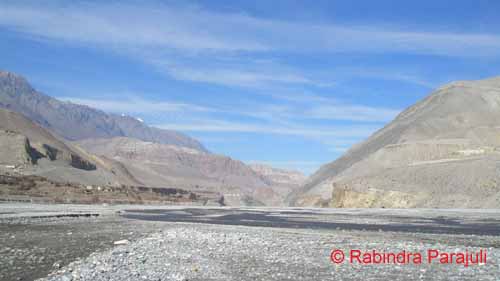Major Routes:
Mustang is one of the major tourist
destinations of Nepal. Many people visit the area not only to experience local culture
and enjoy scenic beauty but also to understand the religious mutualism – which
is being exemplified by the Holy Muktinath Temple. Thousands of National as
well as foreign (mainly Indians) Hindu people visits this temple as a pilgrim.
There are many things to talk about the Mythology, beliefs and other important
aspects of Mustang and Muktinath Temple as well. Which I think is better if it
is dealt details of each site separately. So, for now let’s starts with Major
Route to Mustang in an order of shortest to Longest:-
 |
| Map showing the Route 1: the green line |
Route 1: Pokhara – Jomsome – Muktinath
(the shortest one!)
Area:
Mustang, Nepal
Type
of tour: Eco-cultural/Pilgrimage
Difficulty:
Easy
Hotel
Facility: Available; Average - Standard
Trip
Costs: US$50 - 150 per day per persons (foreign tourists) + Flight charge:
US$ 160 - 200
NRs.1500 – NRs.3500 per day per persons
(national tourists) + Flight Charge: NRs. 4000/7000
Maximum
Elevation: 3850 meter average sea level
Season:
Almost every season
Duration:
4 days
Day 1: Fly from Pokhara to Jomsom (15 minutes
flight) and trek to Kegbeni (2 hrs.)
Day 2: Kagbeni to Muktinath (4 hrs.)
Day 3: Muktinath to Jomsom (5 hrs.)
Day 4: Fly from Jomsom to Pokhara (15 minutes
flight)
Route 2: Pokhara – Beni – Tatopani –
Jomsome – Muktinath
Area:
Mustang, Nepal
Type
of tour: Eco-cultural/Geographical/Pilgrimage
Difficulty:
Medium
Hotel
Facility: Available; Average - Standard
Trip
Costs: US$50 - 150 per day per persons (foreign tourists) + Flight charge:
US$ 80 - 100
NRs.1500 – NRs.3500 per day per persons
(national tourists) + Flight Charge: NRs. 2000/3500
Maximum
Elevation: 3850 meter average sea level
Season:
September – October
Duration:
8 days
Day 1: Drive from Pokhara to Beni
Day 2: Beni to Tatopani
Day 3: Tatopani to Kalopani
Day 4: Kalopani to Jomsom via. Marpha (the
delightful apple kingdom of Nepal)
Day 5: Jomsom to Kagbeni
Day 6: Kagbeni to Muktinath
Day 7: Muktinath to Jomsom
Day 8: Fly from Jomsom to Pokhara
 |
| Map Showing Route 2 (the green line) and Route 3 (the red + green then after): I apologies for poor quality oblique map! |
Route 3: Pokhara – Ghorepani –
Tatopani – Jomsome – Muktinath
Area:
Mustang, Nepal
Type
of tour: Eco-cultural/Pilgrimage
Difficulty: Strenuous
Hotel
Facility: Available; Average - Standard
Trip
Costs: US$50 - 150 per day per persons (foreign tourists) + Flight charge:
US$ 80 - 100
NRs.1500 – 3500 per day per persons
(national tourists) + Flight Charge: NRs. 2000/3500
Maximum
Elevation: 3850 meter average sea level
Season:
March – April and September – October
Duration:
10 days
Day 1: Drive from Pokhara to Birethanti
Day 2: Birethanti to Ulleri
Day 3: Ulleri to Ghorapani (to Pun Hill as
well)
Day 4: Ghorapani to Tatopani
Day 5: Tatopani to Kalopani
Day 6: Kalopani to Jomsom
Day 7: Jomsom to Kagbeni
Day 8: Kagbeni to Muktinath
Day 9: Muktinath to Jomsom
Day 10: Fly from Jomsom to Pokhara
Route 4: Pokhara – Dumre (Tanahu) – Besisahar
(Lamjung) – Chame – Manang – Thorang Phedi – Thorang-La – Muktinath: The Annapurna Circuit trek - longest
one! This takes 2 weeks to get back to Pokhara after a complete circle,
but it is still worthy to enjoy the vastness of Himalayas.
Area:
Manang and Mustang, Nepal
Type
of tour: Ecological – Cultural – Geographical
Difficulty: Strenuous /Tough
Hotel
Facility: Available; Average - Standard
Trip
Costs: US$75 - 200 per day per persons (foreign tourists) + Flight charge:
US$ 80 - 100
NRs.1500 – NRs.3500 per day per persons
(national tourists) + Flight Charge: NRs. 2000/3500
Maximum
Elevation: 5416 meter average sea level
Temperature:
Goes below freezing during Thorang-La cross
Season:
March – April and September – October
Duration: 10 days
Day 1: Drive from Pokhara to Beshisahar (5
hrs.)
Day 2: Beshisahar to Bahaundanda (5.75 hrs.)
Day 3: Bahaundanda to Jagat (4.5 hrs.)
Day 4: Jagat to Dharapani (5 hrs.)
Day 5: Dharapani to Chame (4.75 hrs.)
Day 6: Chame to Pisang (4. 5 hrs.)
Day 7: Pisang to Braga/Manang (3.5/4 hrs.)
Day 8: Manang Rest day (Hike to Icelake)
Day 9: Manang to Ledar (3.5 hrs.)
Day 10: Ledar to Thorangla Phedi/High Camp
(3/4.5 hrs.)
Day 11: Thorangla Phedi/High Camp to Muktinath
(8 to 10 hrs.)
Day 12: Muktinath to Kagbeni via Jhong (3
hrs.)
Day 13: Kagbeni to Jomsom (2 hrs.)
Day 14: Fly from Jomsom to Pokhara (15
minutes)
























